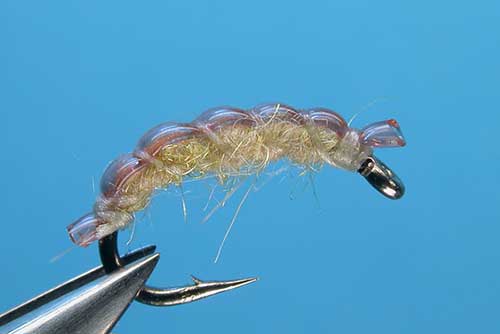Trout Crack
By John Wilson
Translated by Carl Wuebben
Freshwater shrimp (AKA scuds) thrive in many types of water, limestone streams and spring creeks, etc. They provide trout with a year-round food source. Scuds are also an important food source in major tailwater rivers. For many years I read about fly fishers using orange colored patterns to imitate dead or spawning scuds. Whether a trout knows an orange scud represents an easy lifeless meal to pick off or that it contains a belly full of extra protein in the form of eggs is anyone’s guess. Both are workable theories. What we know is that trout see orange scuds on a regular basis, especially in specific locations. Scuds are killed when they flush through the dam turbines. They turn orange and their corpses float through the upper reaches of many tailwaters. Bring a small section of orange scuds with you next time you fish near a dam release or any scud kill zone. You may find yourself with a few additional trout to net. The methods of adding orange to scud patterns are endless. Some tyers use all orange, a hint of orange through the entire pattern, orange hot spots in specific locations, or an orange beadhead. The trout crack was created by John Wilson and is called “a guide-style fly”, which means it takes only a couple minutes to tie. Not pretty to look at, but very effective.
PATTERN
HOOK – Tiemco 2457, or similar sizes #14 to #20
THREAD – UTC clear Mono 0.004, optional 12/0 tan
BODY – Tan or olive Antron or Haretron dubbing
SHELL – The original used orange V-rib but can use tan or brown UTC vinyl rib (small) or liquid lace (midge size)
RIBBING – Clear Mono 0.004 or wire. Thread is optional (in tan)
HEAD – Orange thread – gives the impression of a dead or pregnant scudHOW TO TIE
- Debarb hook (optional) - Mount hook in vice, start thread in a little bit behind the eyelet and wrap rearward to just before the bend of the hook. If using wire this is the time to tie it in, if not continue just a little bit into the bend of the hook.
- Now tie in the orange V-rib shell with the end facing rearward, then pull the front half backward and advance your thread in front of it. Bring your thread forward to about two eyelets from the eye and dub a small noodle with your fingers or a dubbing twister tool. Then wind the noodle rearward with close wraps but not a thick body and stop up against the shell. Pull off any extra dubbing on the thread.
- Pull the shell forward over the top of the body and using the mono thread form the segmentation as you wrap over the top of the V-rib until you get to the front of the dubbing. Then tie off the shell and whip finish and clip the mono off.
- On each end of the shell, clip the ends off but leave a small tag-end on each end.
- Tie on the orange thread behind the eye and form a small head or hot spot (whatever you want to
TIE UP A DOZEN OR TWO – AND GO FISHING*** But remember to practice C.P.R. (CATCH – PICTURE – RELEASE)


